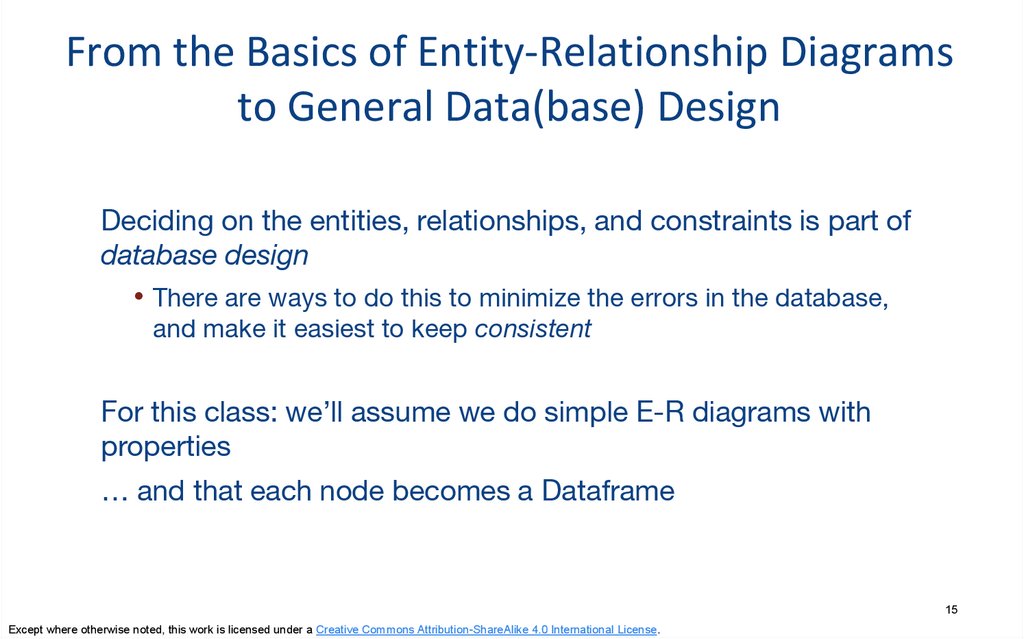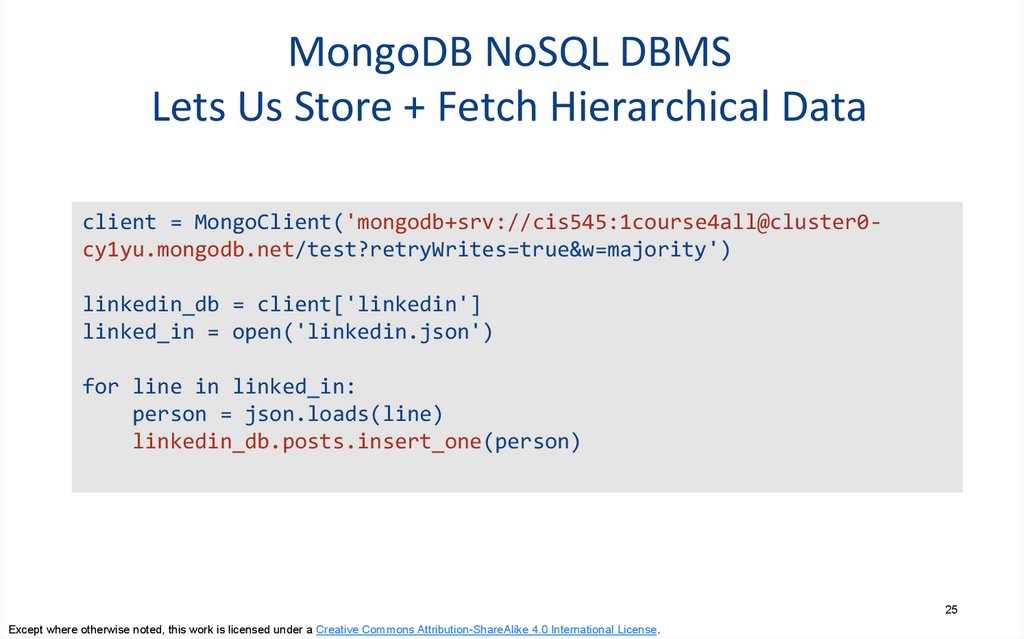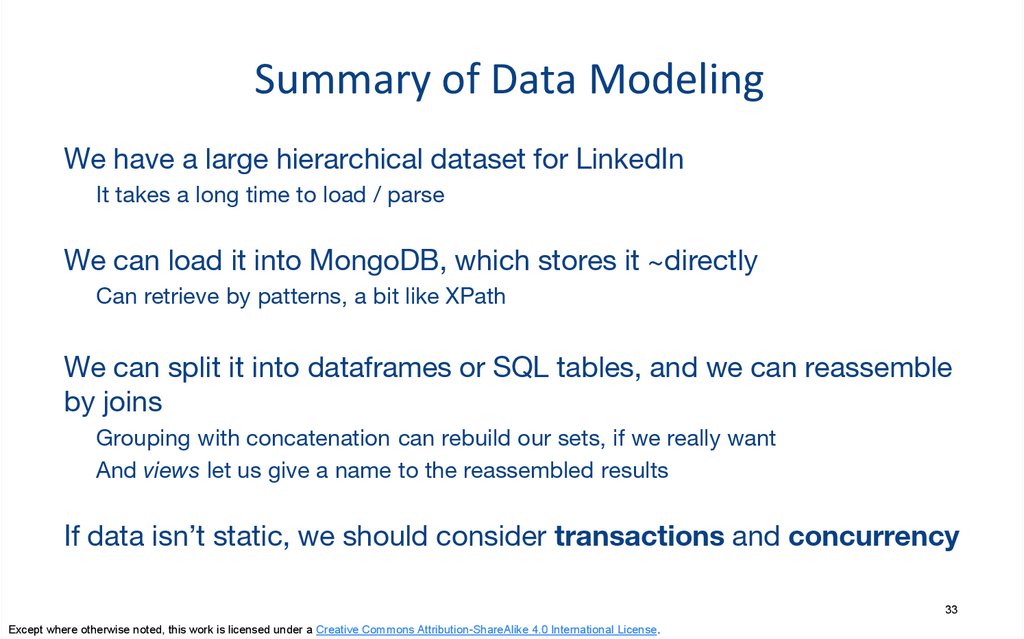Similar presentations:
Data Representation and Modeling
1.
Difficulty level: basicData Representation and Modeling
Except where otherwise noted, this work is licensed under a Creative Commons Attribution-ShareAlike 4.0 International License.
2.
Thinking More Deeply about Data andComputation
We’ve seen:
• semi-structured HTML and unstructured text,
represented using tables to be used for
visualization and learning
• manipulating tabular data
projection (subsetting fields), selection (choosing
rows meeting predicates), loc (extract or update cell),
apply (compute function over each row/col/cell)
• linking tabular data
merge/join, outerjoin, and using string similarity to
join
Now let’s dive into more detail on design:
• How do we encode data?
implications?
What are the
2
Except where otherwise noted, this work is licensed under a Creative Commons Attribution-ShareAlike 4.0 International License.
3.
A First Question:What Are We Trying to Capture?
“Structured data should capture the semantics of the data”
What do we mean by “data semantics”?
This is a topic that has preoccupied philosophers since at least
Aristotle and Plato
… and computer scientists for most of the lifetime of the field!
3
Except where otherwise noted, this work is licensed under a Creative Commons Attribution-ShareAlike 4.0 International License.
4.
Part of the Goal:Modeling Concepts and Instances
"Aristotle" by maha-online is licensed under CC BY-SA 2.0
The famous example from logic and philosophy,
attributed to Aristotle:
• All men are mortal.
• Socrates is a man.
• Therefore, Socrates is mortal.
The premise: we have concepts which are classes
of things, and instances of those concepts
• Properties of the concepts appear in the instances
• Instances relate to other instances
Data design is about trying to codify the above!
4
Except where otherwise noted, this work is licensed under a Creative Commons Attribution-ShareAlike 4.0 International License.
5.
Some Starting PointsWe model knowledge using notions dating back to ancient Greece:
Classes, concepts, or sets of entities – e.g., people
Classes may also have properties, e.g., people have names or are mortal
Instances of those classes – e.g., Socrates, Aristotle, Plato
Named relationships between classes – e.g., people have teachers who are other
people (thus Aristotle has a teacher, namely Plato)
There are different, equivalent ways of looking at these!
Using logic – “knowledge representation,” a key idea in AI
Using entity-relationship modeling – a special case of knowledge graphs
These can all be used to inform our design of dataframes, hierarchical data, etc.
Using knowledge graphs – named relationships between classes, subclasses,
instances, properties
5
Except where otherwise noted, this work is licensed under a Creative Commons Attribution-ShareAlike 4.0 International License.
6.
Modeling Classes, Instances, PropertiesUsing Logical Predicates
"Aristotle" by maha-online is licensed under CC BY-SA 2.0
We can use logical assertions to describe everything.
Classes: named, categorized collections of items
“All people are mortal” : Mortal(person).
Classes have specializations or subclasses:
“Men are people” : Subclass(man, person).
Classes have instances:
“Aristotle is a man” : Instance(Aristotle, man)
And we infer predicates from class to subclass, or class to
instance, using rules:
Mortal(x) ^ Subclass(y, x) Mortal(y)
Mortal(x) ^ Instance(y, x) Mortal(x)
Mortal(person) ^ Subclass(man, person) Mortal(man)
Mortal(man) ^ Instance(Aristotle, man) Mortal(Aristotle)
6
Except where otherwise noted, this work is licensed under a Creative Commons Attribution-ShareAlike 4.0 International License.
7.
We Can Instead Think of thisAs Links between Classes + Instances
Mortal
Life
Stage
subclassOf
Person
… subclassOf
Adult
subclassOf
…
Man
subclassOf
instanceOf
instanceOf
Aristotle
hasTeacher
instanceOf
Socrates
Plato
hasTeacher
7
Except where otherwise noted, this work is licensed under a Creative Commons Attribution-ShareAlike 4.0 International License.
8.
We Can Instead Think of thisAs Links between Classes + Instances
Mortal
… subclassOf
Person
subclassOf
…
Life
Stage
subclassOf
Adult
Here, to determine if Aristotle is Mortal, we
subclassOf
follow links
in
the
graph
(instanceOf,
Man
subclassOf) to see if we can find Mortal.
instanceOf
GoogleinstanceOf
& many other
services use
instanceOf
Knowledge graphs, such as Freebase and
Aristotle
Socrates
Plato
DBpedia
hasTeacher
hasTeacher
8
Except where otherwise noted, this work is licensed under a Creative Commons Attribution-ShareAlike 4.0 International License.
9.
Entity-Relationship Graphs ModelClasses as Named Sets of Linked Instances
ID
Birth
Name
Person
Death
Adult
subclassOf
Man
Name
Birth
1234 Aristotle 384 BC
1233
subclassOf
subclassOf
hasTeachers
(list)
ID
Life
Stage
Plato
Death
322 BC
428 BC 348 BC
1232 Socrates 470 BC
Man is an entity set
with many men, who
are also people
399 BC
Except where otherwise noted, this work is licensed under a Creative Commons Attribution-ShareAlike 4.0 International License.
9
10.
Entity-Relationship Graphs: A Syntax forEntities, Properties, Relationships
ID
Birth
Name
Person
Death
Has
Teacher
“Is a”:
Adult
Is
a
Man
Life
Stage
Is
a
Is
a
subclass inherits all properties of superclass
superclass includes all members of subclasses
10
Except where otherwise noted, this work is licensed under a Creative Commons Attribution-ShareAlike 4.0 International License.
11.
Entities and RelationshipsCorrespond to Relationships or Dataframes!
Person
Entity set: represents all of the entities of a type, and
their properties
• Person: ID, name, birth, death
• Man: inherits the same fields, possibly adds new ones
Man
(not shown)
Has
Teacher
Person
ID
Relationship set: represents a link between people
• HasTeacher(teacher: ID of Person, student: ID of Person)
(Also: Man)
Name
Birth
1234 Aristotle 384 BC
1233
Plato
Death
322 BC
428 BC 348 BC
1232 Socrates 470 BC
399 BC
HasTeacher
Teacher Student
1233
1234
1232
1233
11
Except where otherwise noted, this work is licensed under a Creative Commons Attribution-ShareAlike 4.0 International License.
12.
PersonID
The Tables Let Us Encode a Graph
within the Data!
Name
Birth
1234 Aristotle 384 BC
1233
Plato
HasTeacher
322 BC
Teacher Student
428 BC 348 BC
1232 Socrates 470 BC
student
Death
399 BC
1233
1234
1232
1233
Aristotle
teacher
Plato
student
teacher
Socrates
12
Except where otherwise noted, this work is licensed under a Creative Commons Attribution-ShareAlike 4.0 International License.
13.
PersonID
The Tables Let Us Encode a Graph
within the Data!
Name
Birth
1234 Aristotle 384 BC
1233
Plato
HasTeacher
322 BC
Teacher Student
428 BC 348 BC
1232 Socrates 470 BC
student
Death
399 BC
Aristotle
teacher
Plato
student
teacher
Socrates
1233
1234
1232
1233
In-Class Exercise:
Express using dataframe
operations:
“Who is the teacher of Aristotle’s
teacher?”
“Show the entire tree of people
taught by Socrates”?
13
Except where otherwise noted, this work is licensed under a Creative Commons Attribution-ShareAlike 4.0 International License.
14.
ER is a General Model:A Graph of Entities & Relationships
ID
sequence
Vyas et al, BMC Genomics 2009, A proposed syntax for Minimotif Semantics,
version 1
Except where otherwise noted, this work is licensed under a Creative Commons Attribution-ShareAlike 4.0 International License.
14
15.
From the Basics of Entity-Relationship Diagramsto General Data(base) Design
Deciding on the entities, relationships, and constraints is part of
database design
• There are ways to do this to minimize the errors in the database,
and make it easiest to keep consistent
For this class: we’ll assume we do simple E-R diagrams with
properties
… and that each node becomes a Dataframe
15
Except where otherwise noted, this work is licensed under a Creative Commons Attribution-ShareAlike 4.0 International License.
16.
Considering Non-“Flat” Data16
Except where otherwise noted, this work is licensed under a Creative Commons Attribution-ShareAlike 4.0 International License.
17.
A Common Point of Confusion• “Relational data can only capture flat relationships”
• Not true: it represents graphs, which can be traversed by
queries!
… Though it might be more convenient to represent certain data
structures!
17
Except where otherwise noted, this work is licensed under a Creative Commons Attribution-ShareAlike 4.0 International License.
18.
Hierarchy vs Relations(“NoSQL” vs “SQL”)
Sometimes it’s convenient to take data we could codify as a graph:
Person
owns
Cellphone
And instead save it as a tree or forest:
[{‘person’: {‘name’: ‘jai’, phones: [{‘mfr’: ‘Apple’, ‘model’: …},
{‘mfr’: ‘Samsung’, ‘model’: …}},
{‘person’: {‘name’: ‘kai’, phones: [{‘mfr’: ‘Apple’, ‘model’: …}]}]
This is what NoSQL databases do!
18
Except where otherwise noted, this work is licensed under a Creative Commons Attribution-ShareAlike 4.0 International License.
19.
NoSQL“Not-only SQL”
Typically store nested objects, or possibly binary objects, by IDs or keys
Note that a nested object can be captured in relations, via multiple tables!
Some well-known NoSQL systems:
• MongoDB: stores JSON, i.e., lists and dictionaries
• Google Bigtable: stores tuples with irregular properties
• Amazon S3: stores binary files by key
Major differences from SQL databases:
• Querying is often much simpler, e.g. they often don’t do joins!
• They support limited notions of consistency when you update
19
Except where otherwise noted, this work is licensed under a Creative Commons Attribution-ShareAlike 4.0 International License.
20.
Recap: Basic ConceptsKnowledge is typically represented as concepts or classes, which can
be generally thought of as corresponding to tables
But there is also a notion of subclassing (inheriting fields)
And of instances (rows in the tables)
Knowledge representation often describes these relationships as
constraints
We can capture knowledge using graphs with nodes (entity sets,
concepts) and edges (relationship sets)
Entity-relationship diagrams show this
Entity sets and relationship sets can both become tables!
Graphs + queries can be used to capture any kind of data and relationships (not always
conveniently)
NoSQL systems support hierarchy, which “pivots” the graph into a tree
with a root
20
Except where otherwise noted, this work is licensed under a Creative Commons Attribution-ShareAlike 4.0 International License.
21.
Let’s Work on Data Modeling,Given a Real Dataset!
1. Extracted data from LinkedIn
• ~3M people, stored as a ~9GB list of lines made up of JSON
• JSON is nested dictionaries and lists – i.e., NoSQL-style !
• We’ll focus on how to parse and store the “slightly hierarchical” data
2. Then we’ll work out an example with very hierarchical data – HTML
21
Except where otherwise noted, this work is licensed under a Creative Commons Attribution-ShareAlike 4.0 International License.
22.
22Except where otherwise noted, this work is licensed under a Creative Commons Attribution-ShareAlike 4.0 International License.
23.
Parsing Even Not-So-Big DataIs Painfully Slow!
23
Except where otherwise noted, this work is licensed under a Creative Commons Attribution-ShareAlike 4.0 International License.
24.
Can We Do Better?Maybe save the data in a way that doesn’t require parsing of strings?
https://cloud.mongodb.com
24
Except where otherwise noted, this work is licensed under a Creative Commons Attribution-ShareAlike 4.0 International License.
25.
MongoDB NoSQL DBMSLets Us Store + Fetch Hierarchical Data
client = MongoClient('mongodb+srv://cis545:1course4all@cluster0cy1yu.mongodb.net/test?retryWrites=true&w=majority')
linkedin_db = client['linkedin']
linked_in = open('linkedin.json')
for line in linked_in:
person = json.loads(line)
linkedin_db.posts.insert_one(person)
25
Except where otherwise noted, this work is licensed under a Creative Commons Attribution-ShareAlike 4.0 International License.
26.
Data in MongoDB26
Except where otherwise noted, this work is licensed under a Creative Commons Attribution-ShareAlike 4.0 International License.
27.
Finding Things,in a Dataframe vs in MongoDB
def find_skills_in_list(skill):
for post in list_for_comparison:
if 'skills' in post:
skills = post['skills']
for this_skill in skills:
if this_skill == skill:
return post
return None
def find_skills_in_mongodb(skill):
return linkedin_db.posts.find_one({'skills': skill})
27
Except where otherwise noted, this work is licensed under a Creative Commons Attribution-ShareAlike 4.0 International License.
28.
How Do We Convert HierarchicalData to Dataframes?
Hierarchical data
doesn’t work well
for visualization
or machine
learning
28
Except where otherwise noted, this work is licensed under a Creative Commons Attribution-ShareAlike 4.0 International License.
29.
The Basic Idea: NestingBecomes Links (“Key/Foreign Key”)
people
_id
Overview_html
locality
industry
…
in-00001
<dl id=…
Antwerp Area
Pharmaceu
experience
person
org
title
start
desc
in-00001
Columbia
Assoc…
August
Wor…
in-00001
…
…
…
…
29
Except where otherwise noted, this work is licensed under a Creative Commons Attribution-ShareAlike 4.0 International License.
30.
Reassembling through (Outer) Joinspd.read_sql_query("select _id, org" +\
" from people left join experience on _id=person ",\
conn)
pd.read_sql_query("select _id, \'[\' + group_concat(org) + \']\'" +\
" from people left join experience on _id=person "+\
" group by _id", conn)
30
Except where otherwise noted, this work is licensed under a Creative Commons Attribution-ShareAlike 4.0 International License.
31.
ViewsSometimes we use a query enough that we want to give its results a name, and
make it essentially a table (which we then use in other queries!)
conn.execute('begin transaction')
conn.execute('drop view if exists people_experience')
conn.execute("create view people_experience as " +\
" select _id, group_concat(org) as experience " +\
" from people left join experience on _id=person group by _id")
conn.execute('commit')
pd.read_sql_query('select * from people_experience', conn)
31
Except where otherwise noted, this work is licensed under a Creative Commons Attribution-ShareAlike 4.0 International License.
32.
Occasional Considerations:Access and Consistency
Sometimes we may need to allow for failures and “undo”…
• We saw “BEGIN TRANSACTION … COMMIT”
• There is also “ROLLBACK”
Relational DBMS typically provide atomic transactions for this; most
NoSQL DBMSs don’t
A second consideration when the data is shared: what happens when
multiple users are editing and querying at the same time?
• Concurrency control (how do we handle concurrent updates) and
consistency (when do I see changes)
32
Except where otherwise noted, this work is licensed under a Creative Commons Attribution-ShareAlike 4.0 International License.
33.
Summary of Data ModelingWe have a large hierarchical dataset for LinkedIn
It takes a long time to load / parse
We can load it into MongoDB, which stores it ~directly
Can retrieve by patterns, a bit like XPath
We can split it into dataframes or SQL tables, and we can reassemble
by joins
Grouping with concatenation can rebuild our sets, if we really want
And views let us give a name to the reassembled results
If data isn’t static, we should consider transactions and concurrency
33
Except where otherwise noted, this work is licensed under a Creative Commons Attribution-ShareAlike 4.0 International License.

































 electronics
electronics








